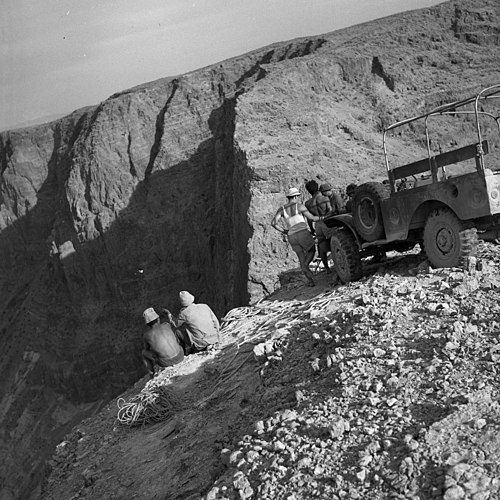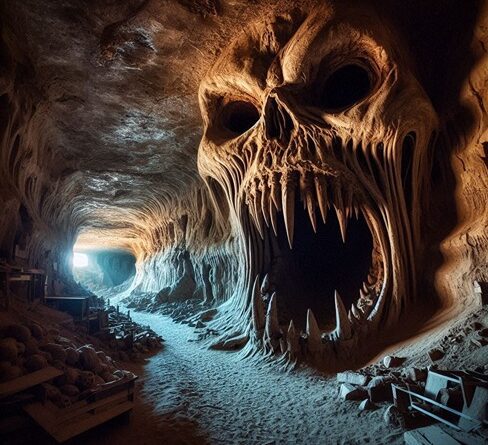Israel’s Cave of Horrors: A Chilling Tale From The Bar Kokhba Revolt
Israel has a rich and fascinating history, with many wars, disasters, and unusual events (and that’s without even mentioning the present of recent years, which is a real horror movie). But how many places are there whose name alone evokes chills, or at least curiosity? The Cave of Horrors in the Judean Desert is precisely such a place. It is an ancient cave that received its nickname after dozens of skeletons of the Bar Kokhba people were discovered there, along with other significant archaeological finds. Today, it is impossible to visit the cave, but understanding its story and what it symbolizes remains essential.
In this article, part of our spine-chilling series on the world’s most terrifying historical sites, we take you deep into one of Israel’s most mysterious locations.
What Is The Cave of Horrors?
The “Cave of Horrors” is the unofficial but more commonly used name for Nahal Hever Cave 8 (8Hev), located in the Judean Desert, near the Dead Sea.
It is located on the southern cliff of Nahal Hever wadi, directly opposite the Cave of Letters on the northern cliff, which received its name due to the discovery of letters from Bar Kochba to the people of Ein Gedi during the Bar Kochba revolt. Researchers also found human remains in this cave, but that is a topic for a separate article.
In 1953, an expedition led by archaeologist Yohanan Aharoni (one of the leading archaeologists in Israel and founder of the Institute of Archaeology at Tel Aviv University) conducted an initial survey in the Nahal Hever area. They arrived at the Cave of Letters and identified the entrance to the new cave, which was called Cave No. 8 or Cave H, simply because it was the eighth cave they had found. It was also nicknamed the “Square Cave” due to the shape of its entrance. The researchers noticed this entrance when they examined the Cave of Letters adjacent to it.

💀 Killer Deals & Scary Recommendations 💀
🎭 Costumes & Accessories
HalloweenCostumes Fun Costumes Entertainment Earth
🛒 Online Shopping
AliExpress Amazon Walmart Etsy
🧛 Collectibles & Horror Brands
Funko Hot Topic Lego Spirit Halloween
🎢 Attractions & Tours
GetYourGuide Tiqets Viator Klook
📖 Blogs & Horror Sites
Bloody Disgusting iHorror Fangoria
🩸 Disclaimer: Some links are affiliate links. The price stays the same – it just helps keep the site alive 👻
The Horrifying Find That Gave The Cave Of Horrors Its Name
The original expedition of Yohanan Aharoni did notice the cave but was unable to reach it. Two years later, a new expedition arrived at the cave and spent several days excavating it. The research findings, as described in the findings compiled by the heads of the Israel Antiquities Authority, show that at one point, the archaeologists discovered the skeletons of about 40 people – including men, women, and, horrifyingly, children and infants. They identified at least five infants and toddlers up to the age of four, nine children up to the age of 15, and five adults. Explorers found skeletons scattered throughout the cave, some still bearing fragments of hair and skin.
In the corners of the inner hall of the cave, archaeologists found several piles of bones that were placed in an orderly manner, and in the back of the corridor, graves that had not been disturbed (meaning, burials in a manner that did not follow the procedures). In one prominent grave, they saw a skeleton lying on its left side, its legs folded (probably due to a lack of space), with its right hand folded in front of its face and its left hand extended downward. Researchers discovered preserved skin, tendons, and hair tips on the skull and several bones. Someone placed a cloth under the head and an iron awl near the pelvis.
Alongside these, several other archaeologically significant discoveries were made, including fragments of writings and letters, a Greek translation of the biblical Twelve Minor Prophets, Bar Kokhba coins, and three inscribed potsherds bearing the names of three individuals who died in the cave. The potsherds were placed on top of the skeletons.
The Cave of Horrors was likely to contain many more items, but Evidence showed that Bedouins had previously excavated the site to loot it. Many of the finds were from the Early Roman period (63 BC to 324 AD), while others were from the Byzantine period (4th century AD to 640), the Early Bronze Age (3300 BC to 2200 BC), and the Chalcolithic period (5800 BC to 3600 BC).
The Siege That Broke The People Of The Bar Kochba Revolt
At the edge of the cliff above the cave, the ruins of a Roman camp were noticed (similar to the camp set up above the Cave of Letters). This Roman camp also sheds light on what happened there, and the story is no less horrific.
The Romans besieged the cave, inside which dozens of Jews hid, and they had no choice but to remain in the cave until they died of hunger or thirst. Although the cave contained food and storage vessels, as well as remains of food, weapons, and objects indicating a prolonged stay by families (such as playing blocks or children’s clothing), it seems that this was insufficient to sustain such a long siege.
According to estimations, the Jews during the Bar Kochba revolt chose the cave as a place of refuge due to its difficult access – in total, there were dozens of caves at that time serving as refuges and hundreds of other hiding places. They probably used ropes to reach complex passages and stockpiled supplies, water, and food. They were willing to hide in the cave for extended periods, but over time, the list of dead grew. The occupants, who were estimated to have been of relatively high status, did not surrender until the last moment in the face of the painful siege.
The Bodies Finally Get Their Graves
For almost two decades, the bones and skeletons from the Cave of Horrors were in the possession of the Israel Antiquities Authority, which kept them in well-secured warehouses. It was not until 1982 that they were officially buried on the northern edge of the Canyon. The burial took place in a dignified military ceremony attended by, among others, the then Prime Minister of Israel, Menachem Begin, and the Chief Sephardic Rabbi, Ovadia Yosef.
In the decades that have passed since then, Vandals have damaged the monument erected to commemorate the dead several times. This occurred in 2007, and a few months later, volunteers renovated the area. In late 2012, volunteers undertook another extensive renovation of the tomb, which included the installation of a metal plaque commemorating those who had fallen.
In 2019, a comprehensive project was conducted to dig in the caves in the Judean Desert, following a preliminary survey that had uncovered, among other things, a sandal nail, an ancient sandal, and coins. Among other things, during the excavations, parts of the Dead Sea Scrolls from the time of the Bar Kokhba revolt, with verses from the Twelve Minor Prophets, were discovered in the Cave of Horrors. The more horrifying find was a skeleton, approximately 6,000 years old, likely that of a female girl between 6 and 12, which was placed in a designated pit surrounded by stones and wrapped in cloth. The skeleton underwent a meticulous natural mummification process, resulting in impressive preservation of the skin, hair, and tendons.
In 2021, archaeologists discovered new fragments belonging to the Dead Sea Scrolls found earlier, with a slightly different translation and the name of God, the only ancient Hebrew word between Greek letters.
Can You Visit Israel’s Cave Of Horrors?
Access to the Cave of Horrors is considered complex by any standard. The cave’s entrance is on a cliff approximately 180 meters high, with a nearly vertical shape. The cave’s entrance is situated approximately 76 meters below the cliff’s edge. You don’t have to be an expert to understand that the descent into the cave is only possible with the help of rappelling equipment. This is a complex task involving a steep descent of approximately 300 meters through tracks, natural stairs, scree, and sections of cliff. In other words, a task that resembles the beginning of a horror cave movie.
It is important to note that over the years, the direct access routes to the cave have completely collapsed. Today, the cave is under the responsibility of the Israeli Nature and Parks Authority (NPA), which has completely banned access to it.
So what can you do? First, take a walk in the area, as it is awe-inspiring and of historical significance. Within a short distance, you will find, for example, Ein Gedi (approximately 6 km away), the Dragot Cliffs, and Mount Tzruya. To visit the area, you enter the Judean Desert Reserve, where there is a black jeep trail, from which you can switch to a green trail that will take you to Nahal Hever very close to the Cave of Horrors. You can look out over the cave from the northern cliff.




